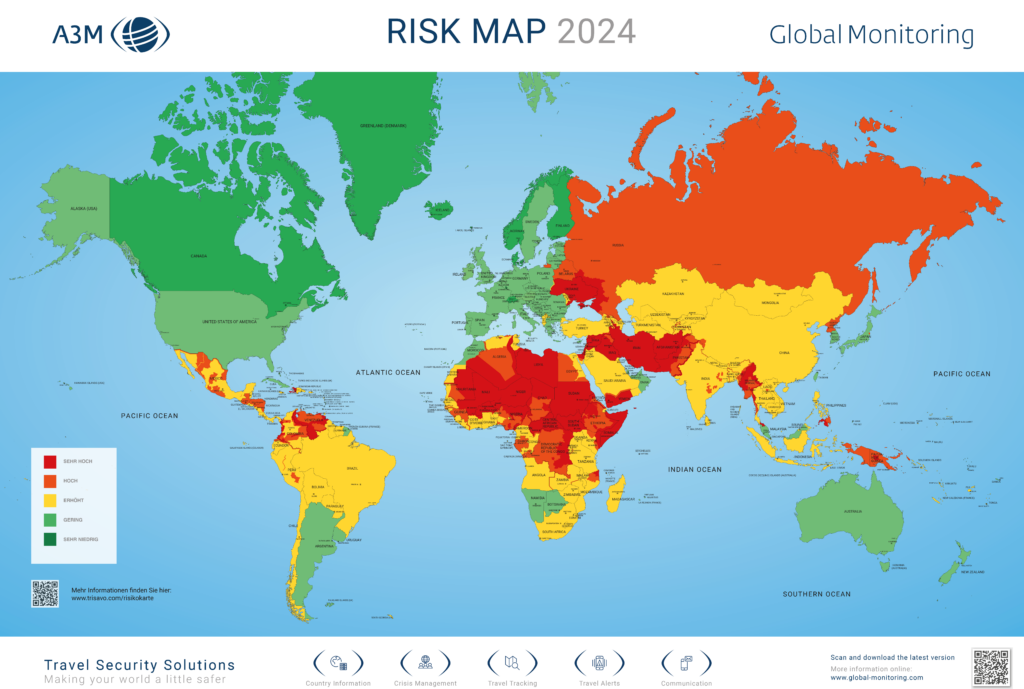The world is
constantly moving
This makes it all the more important to be able to rely on a dedicated expert assessment of the security situation worldwide. Our risk classification provides an important indication of this. Our security map, which we update periodically, represents a snapshot of our risk assessment.
The risk classification is made up of assessments of the following categories:
Entry and exit, transport (plane / air transport, long-distance public transport, local public transport, taxis, cars / rental cars, other means of transport), strike, infrastructure (money, telephone / mobile communications, internet, electricity), health (vaccinations, infection risks, hygiene, health care), natural hazards and the environment, security (crime, demonstrations/unrest, terrorism, armed conflict), economic security (corruption, industrial espionage) and special risks (cultural characteristics, LGBTQ, female travelers, criminal law characteristics and other risks).
A variety of factors therefore play a role in the classification of countries and regions. Countries and regions for which travelers should definitely inform themselves about country-specific risks before a trip are marked using the signal colors orange and red. In principle, however, relevant information is also stored in countries with lower risks for travelers.
Very low risk (dark green)
The country/region can be travelled to without restrictions/constraints and travellers face very few special risks.
Violent crime against travellers/foreigners is rare and there are no particular risks from natural hazards or in terms of health. Security forces and rescue services are readily and reliably available. In the areas of transport and infrastructure, high standards are maintained. Terrorist organizations can operate in the country, but to a limited extent at most, thus the level of threat from terrorism is not covered in these countries/regions. Violent protests are relatively uncommon and/or very localized. Strikes in essential services (e.g. security/emergency services) very rarely occur, if at all. Severe weather can occur, though is rarely destructive on a significant scale.
Low risk (light green)
The country/region can be travelled to with only few restrictions/constraints and travellers face only a low level of risk.
Risks potentially affecting travel and requiring special measures/precautions might arise in the areas of strike, health, natural hazards, crime and/or demonstrations. Attention should therefore be paid to those country-specific categories. Travel might, for example, be restricted due to tropical diseases, strikes, natural disasters (e.g. earthquakes, tropical storms, seasonal weather phenomena), violent crime or an increase in protest activity. Travellers are advised to consult the country-database (providing situation reports & instructions) so as to inform themselves about possible risks at their travel destination.
Increased risk (yellow)
Travellers face increased risks but there is little need to take extra precautions when travelling to the country/region.
The security situation could be tense due to widespread violent crime and/or there could be significant health risks, natural hazards, or other special risks. Prolonged, violent protest is possible. Travellers should exercise increased vigilance and to consult the country-database (providing situation reports & instructions) prior to departure so as to inform themselves about destination-specific risks and advice.
High risk (orange)
Travellers face a high level of risk, and should expect restrictions in the country/region.
Special arrangements (e.g. tailored security plans) should therefore be made prior to departure. Travel to these areas is mostly advised against. The security situation in parts of the country is very tense due to armed conflicts, terrorist organizations, substantial violent crime, and/or frequent unrest. Affected areas may be difficult to access by travellers. Travellers are advised to exercise particular caution and to consult the country-database (providing situation reports & instructions) prior to departure in order to thoroughly inform themselves about destination-specific risks. Special security precautions are often necessary if travel to the country/region is intended.
Very high risk (red)
Travellers face a very high level of risk and should expect considerable restrictions when travelling the country/region.
Travel might even be entirely impossible. It is necessary to take extensive precautions (e.g. tailored security plan) and to complete a detailed travel itinerary prior to departure. Travel to these areas is fundamentally advised against. The security situation is likely extremely tense due to armed conflicts, terrorist organizations, extensive violent crime and/or unrest, and the government has little to no control over large parts of the country. Security forces and rescue services are rarely available, if at all. Affected areas may furthermore be difficult to access for travellers. Travellers are advised to not commence their travel without having thoroughly informed themselves about destination-specific risks via the country-database (providing situation reports & instructions), or without following those instructions and excersising an extreme level of care.

